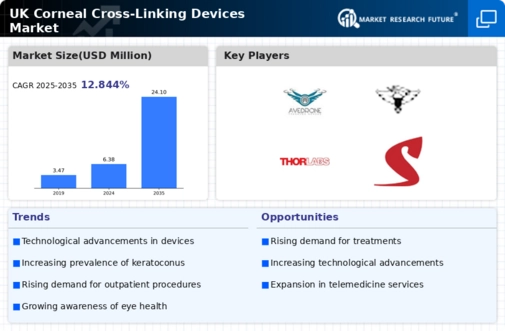Enhanced Clinical Outcomes
The corneal cross-linking-devices market is driven by enhanced clinical outcomes associated with the procedure. Studies indicate that corneal cross-linking significantly improves visual acuity and stabilizes the cornea in patients with keratoconus. As clinical evidence supporting the effectiveness of this treatment accumulates, more ophthalmologists are likely to recommend it to their patients. This growing confidence in the procedure is expected to translate into increased adoption of corneal cross-linking devices. The market could see a growth trajectory of around 14% as patient satisfaction and positive clinical results encourage wider acceptance and utilization of these devices in the UK.
Growing Geriatric Population
The aging population in the UK is a notable driver for the corneal cross-linking-devices market. As individuals age, the risk of developing corneal diseases, including keratoconus and ectasia, increases. This demographic shift is expected to lead to a higher demand for effective treatment options, including corneal cross-linking. With the elderly population projected to rise significantly, healthcare providers are likely to focus on offering specialized services to cater to this group. Consequently, the market may experience a growth rate of approximately 8% as more elderly patients seek interventions to preserve their vision and quality of life.
Rising Incidence of Keratoconus
The increasing prevalence of keratoconus in the UK is a significant driver for the corneal cross-linking-devices market. Keratoconus, a progressive eye disease that leads to the thinning and bulging of the cornea, affects approximately 1 in 2,000 individuals. As awareness of this condition grows, more patients seek treatment options, thereby boosting demand for corneal cross-linking devices. The corneal cross-linking procedure has been shown to halt the progression of keratoconus, making it a preferred choice among ophthalmologists. This rising incidence is likely to propel the market forward, as healthcare providers aim to offer effective solutions to manage this condition, potentially increasing market revenues by an estimated 15% over the next few years.
Increased Investment in Eye Care
The corneal cross-linking-devices market benefits from increased investment in eye care infrastructure within the UK. Government initiatives and private sector funding are directed towards enhancing ophthalmic services, which include the adoption of advanced technologies for treating corneal diseases. This financial support is crucial for the development and distribution of innovative corneal cross-linking devices. As hospitals and clinics upgrade their facilities and equipment, the accessibility of these devices improves, potentially leading to a market growth of around 10% over the next few years. This trend indicates a commitment to improving patient outcomes and expanding treatment options in the UK.
Advancements in Surgical Techniques
Innovations in surgical techniques for corneal cross-linking are transforming the landscape of the corneal cross-linking-devices market. Techniques such as accelerated cross-linking and transepithelial cross-linking are gaining traction, offering improved outcomes and reduced recovery times for patients. These advancements not only enhance the efficacy of the treatment but also expand the patient base eligible for the procedure. As more ophthalmic surgeons adopt these techniques, the demand for advanced corneal cross-linking devices is expected to rise. The market could witness a growth rate of approximately 12% annually as these new methods become standard practice in the UK, reflecting a shift towards more patient-centric care.















Leave a Comment